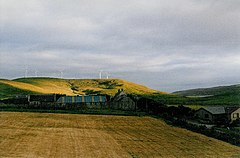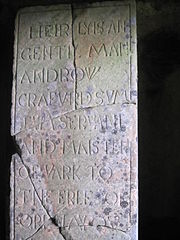Tingwall, Shetland
| Tingwall | |
| Shetland | |
|---|---|
 Veensgarth, with Burra Dale and the Loch of Tingwall | |
| Grid reference: | HU416428 |
| Location: | 60°10’5"N, 1°15’3"W |
Tingwall is a parish in Shetland, mostly on Mainland, and the designation of a hamlet by the Loch of Tingwall here. The hamlet lies about four miles north-west of Lerwick. The old capital, Scalloway, lies in the parish, at its southern end, and this is appropriate as the name "Tingwall" suggests its place as the central gathering place of the islands. The parish is at the head of a long narrow bay. Tingwall Airport is in the north of the parish.
The name "Tingwall" is Old Norse, from Þingvöllr meaning "Thing Field" (a "thing" being a Norse assembly). There is also a parish of Tingwall on Orkney Mainland, and several places of similar name and derivation across the British Isles, not to mention Norway and the famous Þingvellir in Iceland.
Parish
Tingwall parish includes:
- Scalloway
- Whiteness
- Veensgarth
- Gott,
- The Vallafield housing estate.
The centre of the parish was the Tingwall Kirk.[1] It comprehends a section of Mainland, stretching from the Atlantic at Scalloway, to the North Sea at Rova Head and includes the formerly inhabited islands of Hildasay, Langa, Linga, and Oxna. [2]
The Mainland section is divided into two districts by a hill ridge, and comprises two parallel valleys (nearly at right angles from the ridge). The Tingwall valley extends north from near Scalloway to the south end of Lax Firth. It is diversified by the lochs of Tingwall, Girlsta, Asta, Strom and some others.
It is so indented by the sea as to contain no point farther than two miles from it. Measured across marine intersections, it has a length of about nineteen miles, and a maximum breadth of ten miles.
History
The small promontory at the end of Tingwall Loch, known as Tingaholm or Law Ting Holm was once home to Shetland's earliest parliament. It was once an islet entirely surrounded by water and accessed by a stone causeway. In the 1850s the level of the loch was lowered, and the holm took on its present form.[3]
Tingwall was also the base of the Archdeaconry in Shetland. The present day church lies on the site of a much older building, originally dedicated to St Magnus. The burial vault in the churchyard is believed to belong to this earlier building, which is thought to have had a round tower, similar to that of the St Magnus Kirk on Egilsay, Orkney.
There are a number of ancient and historical monuments in Tingwall, including a standing stone [4] known as the murder stone. This stone is traditionally said to be the site where the Earl of Orkney killed his cousin in a power struggle over Shetland. Local folklore also suggests that a person could escape punishment at the Thing if they were able to run to the stone and claim sanctuary. Other versions of this story involve running to the Kirk, or the nearby croft at Griesta.
Tingwall was the home of brothers Laurence I Graham (Lollie) and John J Graham, two of Shetland's most influential 20th Century Writers.
Wildlife
Tufted Duck, Red-breasted Merganser and Common and Black-headed Gull frequent the loch, which is also home to Shetland's only Mute Swans.[5]
Outside links
References
- ↑ Tingwall Church (The Church of Scotland)
- ↑ Turnbull, Rev John (1845). The New Statistical Account of Scotland: Sutherland, Caithness, Orkney, Shetland, General index. The New Statistical Account of Scotland. 15. W. Blackwood and Sons. p. 59.
- ↑ Law Ting Holm (Royal Commission on the Ancient and Historical Monuments of Scotland)
- ↑ Loch of Tingwall (Royal Commission on the Ancient and Historical Monuments of Scotland)
- ↑ "Tingwall Central Mainland Law Ting Holm Shetland Parliament". iknow-scotland.co.uk Retrieved 15 August 2010.
- Shetlopedia: Tingwall, Shetland
Books
- Wilson, Rev. John The Gazetteer of Scotland (Edinburgh: 1882) Published by W. & A. K. Johnstone
- Tudor, J. R. The Orkneys and Shetland: Their Past and Present State(London: 1883) Published by Edward Stanford)
- Fojut, Noel (1994) A Guide to Prehistoric and Viking Shetland (Shetland Times) ISBN 978-0-900662-91-1

